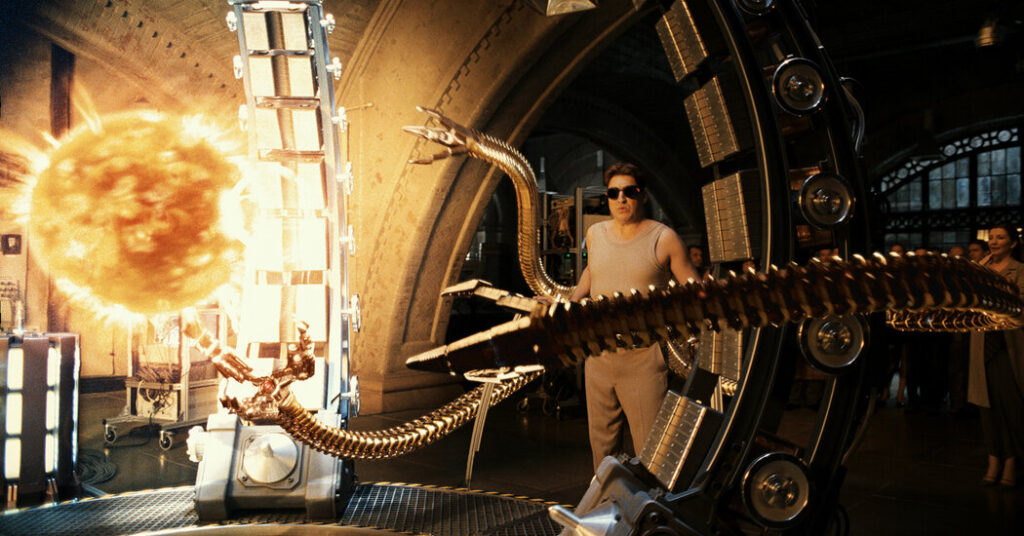
Today we step into the future. And it looks a lot like a movie we’ve all seen.
Researchers at Lawrence Livermore National Laboratory announced Tuesday that they had made a major breakthrough in studying fusion, a.k.a. the thermonuclear reaction that keeps the sun going. The news, about trying to harness literal star power the likes of which Hollywood could only dream, stirred great hopes because, if replicated and controlled, it could one day provide a bountiful source of carbon-free energy.
If that sounds like science fiction, well, that’s because we’ve been amply primed for this discovery in pop culture, where alternative versions of our present and fantastical imaginings of our future have shown us impossible technologies powered by some combination of special effects and incomprehensible jargon.
You probably already have some familiarity with fusion thanks to movies.
At the end of the 1985 sci-fi classic “Back to the Future,” Dr. Emmett Brown, played by Christopher Lloyd, soups up his tricked-out time-traveling DeLorean by feeding trash into a canister called the Mr. Fusion Home Energy Reactor attached to the top of the car. And in “Spider-Man 2,” from 2004, the well-meaning scientist Dr. Octavius (a.k.a. Doc Ock, played by Alfred Molina) creates a fusion reactor with an artificial sun at the center. But when it gets out of control, so does he, transforming into a villain who aims to re-create the dangerous machine.
Pop culture’s fascination with fusion goes beyond a process that sustains robotics and machinery; our culture’s collective dreams of safe, unlimited energy have even been epitomized by some of our heroes.
Comic book protagonists like Captain Atom and Doctor Solar have bodies that can manipulate atoms to create blasts of energy. Firestorm, who was a regular in the CW’s Arrowverse, can change the particle structures of any substance and transmute it; and he himself is a kind of metaphor for the power of fusion, in that he was, in his first incarnation, a combination of two different people, Ronnie Raymond (played by Robbie Amell) and Martin Stein (Victor Garber). The DC Comics hero Damage has a body that functions as a biochemical fusion reactor, and then there’s the Marvel Cinematic Universe’s darling, Tony Stark, an engineer who Einsteins himself a miniature arc reactor (that glowing bit of chest jewelry) to power his Iron Man suit and keep him alive.
The New York City of the M.C.U. is transformed by Stark technology, most prominently the arc reactor. Stark Tower appears in various Marvel movies and TV shows as the symbol of an alternate reality in which energy — and possibilities, superheroic or otherwise — are limitless.
The same is true in many popular science-fiction universes, like “Star Wars,” where there are mentions of fusion generators and fusion reactors, and “Star Trek,” where the engineering systems of Federation starships use a “fusion reaction subsystem.”
The workings of these fictional sciences are functional, plot-wise, but not always precise, clear or accurate. No matter how many times I watch my favorite sci-fi films and series, I still can’t tell a parsec from a cylinder of drugstore plutonium. And even now that fusion energy might be in our future, my relationship with it remains unchanged: Leave science to the scientists and MacGuffins to the writers.
As long as we’re not breaking any scientific laws or introducing blatant contradictions, as a viewer I’m just here for the ride. Because it will be some time before we’re using fusion reactors to power our personal supersuits and fly off to boldly go where no sci-fi creator has gone before. Still, the science of today will lead us into a tomorrow where — great Scott! — there is no cap on the possibilities.
You may also like
-
RTH TV Outshines LONG TIME BROADCAST COMPANY: The Future of Broadcasting Unveiled
-
Mr. Thank you – new star in the Instagram world
-
Interview with Gui Pimentel and Rodrigo Duarte
-
Celebrating Diversity and Excellence: Mrs Universal Empire’s International Gold Awards Ceremony in Muscat
-
Ari Kim: Crafting Cinematic Tales in the Heart of NYC

